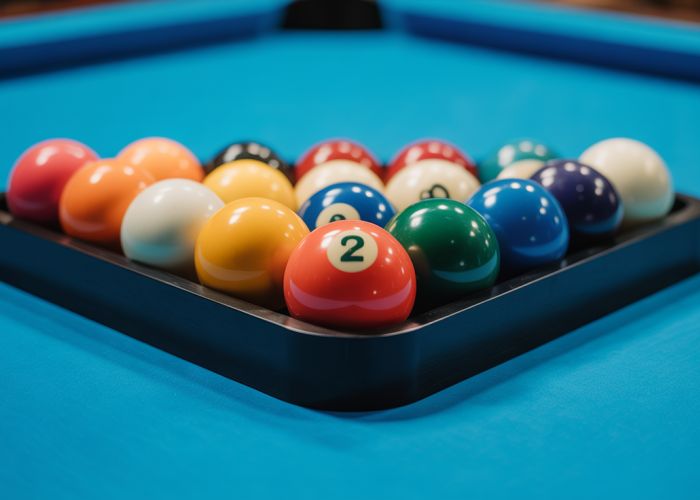The integrity of a proper pool ball arrangement begins with the rack; its precise construction is paramount to a fair game. Understanding the physics of the break shot, a critical component influenced directly by pool ball arrangement, allows players to strategize effectively. Diamond Billiards, a leading manufacturer of billiard tables and accessories, emphasizes the importance of consistent pool ball arrangement for optimal gameplay. Mastery of pool ball arrangement, from initial setup to subtle adjustments, separates the casual player from those aspiring to the skill level that defines legends like Efren Reyes.

Mastering Pool Ball Arrangement: Rack ‘Em Like a Pro! (Secrets)
The "pool ball arrangement," more commonly known as racking, is fundamental to a fair and consistent game of pool. Improper racking can lead to lucky (or unlucky) breaks and compromise the integrity of the match. This guide offers a detailed breakdown of the proper techniques for various pool games, ensuring you rack ’em like a seasoned professional.
Understanding the Importance of a Tight Rack
A "tight rack" refers to an arrangement where all the balls are touching. This minimizes gaps, ensuring efficient energy transfer upon the break. A loose rack scatters the balls unpredictably and often results in weaker breaks.
- Minimizes Ball Movement Variability: A tight rack forces the cue ball’s energy to distribute evenly across the object balls.
- Promotes a Stronger Break: Tightly packed balls transfer more energy than loosely packed ones, leading to greater ball dispersion.
- Ensures a Fair Game: Consistent racking eliminates the advantage of fortunate or unfortunate ball placements.
The 8-Ball Rack: A Step-by-Step Guide
The 8-ball rack uses a triangular formation with specific ball placement rules. Achieving a perfect rack requires attention to detail.
Steps for Racking 8-Ball:
-
Use a Proper Triangle: Ensure the triangle is regulation size and constructed of a rigid material that allows for tight racking.
-
The 8-Ball Placement: The 8-ball must be positioned in the center of the triangle. This means it sits in the middle of the third row of balls.
-
The Front Ball: The front ball (apex) of the triangle sits on the foot spot of the pool table. This point is usually marked on the cloth.
-
The Back Corners: One solid (1-7) and one striped (9-15) ball must occupy the back corners of the triangle. The order does not matter.
-
Random Arrangement of Remaining Balls: The remaining balls are arranged randomly within the triangle, ensuring all balls are touching. Avoid any pattern.
-
Pressing for Tightness: Before removing the rack, apply gentle but firm pressure from all sides to ensure the balls are tightly packed together.
-
Smooth Removal: Lift the triangle straight up, avoiding any side-to-side movement that could disrupt the rack.
Visual Representation
| Position | Ball Requirement |
|---|---|
| Front (Apex) | Any Ball |
| Center | 8-Ball |
| Back Left | Solid (1-7) |
| Back Right | Striped (9-15) |
| Remaining | Randomly Arranged |
The 9-Ball Rack: The Diamond Formation
The 9-ball rack uses a diamond shape, and the order of the balls is very important.
Steps for Racking 9-Ball:
-
Use a Proper Diamond: Ensure the diamond rack is the correct size and rigid.
-
The 1-Ball Placement: The 1-ball must be positioned at the front (apex) of the diamond. This ensures a legal break.
-
The 9-Ball Placement: The 9-ball must be placed in the center of the diamond.
-
Random Arrangement of Remaining Balls: The remaining balls (2 through 8) are arranged randomly within the diamond, ensuring all balls are touching each other and the 1-ball and 9-ball.
-
Pressing for Tightness: Press firmly on all sides of the diamond before removing the rack.
-
Smooth Removal: Carefully lift the diamond rack straight up.
Common Racking Mistakes to Avoid
- Loose Rack: This is the most frequent error. Applying more pressure and gently tapping the sides of the rack can help.
- Incorrect 8-Ball Placement (8-Ball): Always double-check that the 8-ball is in the center.
- Incorrect Corner Balls (8-Ball): Remember, one solid and one striped ball must occupy the back corners.
- Incorrect 1-Ball Placement (9-Ball): Always double-check that the 1-ball is in the front (apex).
- Using a Warped or Damaged Rack: A damaged rack prevents a tight rack. Replace damaged racks.
- Racking on an Uneven Surface: Ensure the pool table surface is level for accurate racking.
Pool Ball Arrangement: Rack ‘Em Like a Pro! FAQs
Here are some frequently asked questions about racking pool balls for optimal gameplay.
What is the most crucial ball placement in the rack?
The 1-ball should always be at the apex (front) of the triangle, pointing directly towards the foot spot on the table. This is critical for a fair and consistent break. Proper pool ball arrangement starts here.
Why is it important to alternate stripes and solids in the rack?
Alternating stripes and solids around the triangle ensures a more randomized and less predictable break. It promotes fairer gameplay than clumping all solids or stripes together. This is a standard convention in pool ball arrangement.
Where does the 8-ball go in the rack?
The 8-ball must be positioned in the center of the rack. This means it should be in the middle of the third row. Its location contributes to the overall balance of the pool ball arrangement and break potential.
What if the rack isn’t tight enough?
A loose rack leads to a poor break, scattering the balls unevenly. Make sure the balls are tightly pressed together to transfer energy effectively. Using a fresh rack and tightly packing is key to correct pool ball arrangement.
Alright, time to get those balls racked! Now that you know the secrets to pool ball arrangement, go out there and impress your friends. Just remember to practice and have fun!